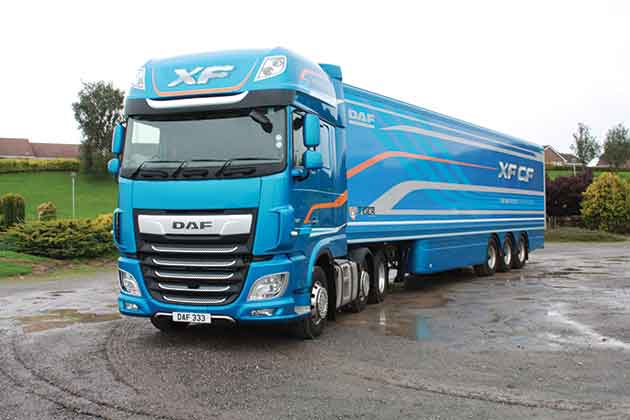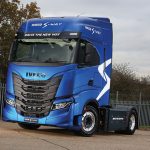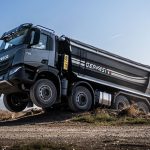
The New XF comes with subtle upgrades that can be easily overlooked. Kevin Swallow took DAF’s flagship around Scotland to see if the changes bolster to its reputation with drivers and owners.
LAST YEAR DAF Trucks introduced its new generation of Euro 6 trucks citing improved fuel efficiency and lighter kerbweight.
On the outside there has been a little cosmetic surgery to the front grille and bumper and the addition of reflective strips above and below the windscreen.
The real work however has been underneath the cab and on the chassis, which contribute to a claimed 7% improvement in fuel efficiency, a figure quoted at the 2017 CV Show by the current Paccar executive vice president Preston Feight.
For the purposes of this test, Transport News is focussing on the Paccar MX13 engine. All the power outputs have been given a hike of 20hp and with torque levels raised 200Nm. With the ‘multi torque’ function, the engine actually delivers an additional 100 to 150Nm on the highest gear. This is the trend of ‘down seeding’ where the truck operates for longer periods in the highest gear to improve fuel consumption and performance. What’s more, the bottom end of the peak torque band dips below 1,000rpm to 900rpm. More on that later.
REAR AXLE RATIOS
An important component of the new, faster powertrains are the rear axles with new ratios. On R60 wheels, 2.05:1 is now available, on R70s the lowest final ratio option is 2.21:1, designed to cruise at top speed as close to 1,000rpm as possible.
To make this work the latest generation of ZF TraXon 12 speed automated gearboxes come with specific software to manage shift settings for different activities from economy driving to heavy haulage.
Plus, it is lighter. The two axle tractor drops 100kg, while the 6×2 loses 130kg. Savings are made with a series of refinements, but the most significant is the new, smaller aftertreatment system that saves 50kg.
For this test, DAF Trucks specified the XF 6×2 badged at 480 with the Super Space Cab. The 12.9 litre MX13 engine complies with Euro 6 emissions using exhaust gas recirculation (EGR), together with a diesel particular filter (DPF) and selective catalytic reduction (SCR).
The MX13 range includes three options nominally badged as 430, 480 and 530hp, each with additional torque at low revs in the highest gear for direct drive gearboxes and in the two highest gears for overdrive gearboxes.
Our test vehicle is the middle one; it has a true rating of 476hp peak power at 1,600rpm. With a direct drive 12 speed TraXon automated gearbox the first 11 gears benefit from 2,350Nm peak torque between 900 and 1,365rpm, while in 12th gear its 2,500Nm between 900 and 1,125rpm. To get the low torque from the driveline the final axle ratio is 2.38:1, which is the second lowest available on R70 wheels.
Much of how the truck operates on long haul is revealed travelling up the first section of motorway as Carlisle transitions onto the M74.
The rotary switch for the transmission is by the left knee, gear selection is on the right stalk with the button on the end switching between ECO, standard and manual. On the right side of the steering wheel is cruise, the limiter, and speed adjustment.
Once up to motorway speed the now standard fit adaptive cruise control (ACC), predictive cruise control (PCC) with eco-roll and the eco-setting on the transmission were all engaged.
This test was run at 53mph on the motorway, designed to keep the truck out of the way of commercial traffic as drivers chase delivery times.
Cruising at a tad over 1,050rpm the truck takes the first undulating section of the M74 northbound to J16 in its stride, and it must be said that PCC is a must have for every haulier. It saves fuel, simple as that, without the driver having to eke out a solid fuel return with an ever present vigilance on climbs, hill cresting and descents. It offers consistency.
Eco-roll kicks in repeatedly until the gradual climb towards Beattock, which was tackled in Eco mode. It allowed the revs to drop a little lower and dig in before shifting up from around 1,000rpm. The change is swift because the engine needs to be working, so it re-engages 11th gear at 1,200rpm to get the truck to the top.
For the timed hill climbs, I changed out of the eco gear setting to standard and this produced the highlight of the road test.
As a 480, it wasn’t expected to trouble the leaders board and it went true to form climbing the 2.5 mile Cairnie Braes Hill Climb eastbound on the A9 Dunblane-Perth road starting at Findo Gask.
It delivered a run-of-the-mill three minutes 19 seconds, some seven seconds off the pace compared to current record holder; the Mercedes-Benz Actros1 2563LS with 630hp and 3,000Nm torque (TN, August 2018).
However, on the second hill climb up Balmanno Hill, a climb on the M90 southbound from J9 at Bridge of Earn up a 3.6 mile stretch with a 7% ascent, it topped out at four minutes 16 seconds, matching the climb’s leader, the same Actros1. The 480 dropped to 45mph at its slowest point and 10th gear, and then it dug in and retained momentum to the top. It has to be said that was some performance!
WORKED ON THE FLAT
Through the A-road section of the test from Edinburgh down the A702 to Abington services, the truck happily worked on the flat at 950rpm in top gear. Using PCC where possible saw eco-roll kick in several times, but the majority was done with the limiter set at 40mph in top gear for the level sections.
The updated Super Space Cab has a revamped dashboard and a new top of the range interior known as Exclusive Line. You’ll know if you have one as it uses brown (or cognac) for selected parts of the dashboard, door panels for the XF and leather seats, and it also comes with a leather steering wheel.
It creates a comfortable working area for the driver although it lacks a split backrest, which for longer shifts in the saddle is welcomed by many drivers.
As part of the overall upgrade DAF redesigned the instrument panel and the driver can move switches around. For drivers looking to get the most from their working day, the Driver Information Panel includes a tachograph countdown that shows remaining minutes for both driving and resting times.
Standing height is 2.25m from the footwell to the ceiling. The engine tunnel sits at 15cm offering an overall height up to 2.10m in the centre of the cab.
The cockpit design of the dashboard means the central part eats into the standing space in front of the bunks. Storage remains a strong feature in the Super Space cab with under bunk space, plus lockers above the windscreen.
Width of the bottom bunk is 81cm with a similar 81cm above the head to the upper bunk, which is 11cm narrower and has just 63cm head space.
In cooler environments, the cab can be kept warm up to an hour using heat generated by the engine’s coolants before the night heater kicks in.
What stands out from this road test is the down speeding, and how it operated. Lugging down in the economy mode to use less rpm, and thus use less fuel, is fine on the long haul, but can be detrimental if the truck labours on hill climbs.
While there was a noticeable difference climbing in the standard gear setting, the overall trip for the test matched the running time of trucks using greater horsepower and torque. Perhaps, all that was achieved was a quicker climb that required more fuel rather than any long term benefit.
Either way, DAF’s latest version of the XF, with a hike in power and torque levels, combined with a spacious working environment gives the brand a decent shot in the arm for both drivers and operators.
Ends
Case study: Stalkers Transport Services
STALKERS Transport Services in Brampton, Cumbria, reported ‘an uplift in fuel economy’ in the weeks following the arrival of six DAF New XF480 tractor units with Super Space Cabs and ‘FTG’ 6×2 twin steer axle configurations.
Fuel figures are up to 8.5mpg and improving week on week, compared to the company’s same spec DAF CF models, that returned an average economy of 7.8mpg.
‘We’ve always been a DAF operator,’ says MD Karen Stalker, ‘it’s a great product supported by an exceptional local dealer, Solway DAF in Carlisle, with whom we have enjoyed a fantastic relationship for 35 years.’
She added: ‘Fuel, of course, is the big cost and we’re delighted that the New XFs are providing a significant uplift in economy. The demonstrator was worked very hard indeed and an 8.9mpg average was a remarkable achievement following such a tough work out.
‘The new truck has already boosted our fleet average by over 8.5% and we’re delighted with that. The introduction of DAF driver training has had a positive impact on economy too.’
The upgrade in running gear was also applied to improve the driver’s working environment. ‘The Super Space Cabs provide them with all the creature comforts. I believe a happy driver is a productive driver and the DAFs will certainly help us retain the better ones, especially in this part of the world where excellent, loyal drivers are at a premium,’ she added.
Since installing telematics across the fleet, Stalkers has been able to reduce its fuel spend from 42% to 30% of its overall fleet running costs. The company also reports that the fitment of forward facing cameras has drastically reduced insurance claims.




